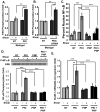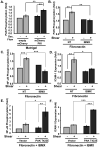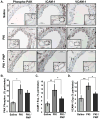Matrix-specific protein kinase A signaling regulates p21-activated kinase activation by flow in endothelial cells
- PMID: 20224042
- PMCID: PMC2862370
- DOI: 10.1161/CIRCRESAHA.109.210286
Matrix-specific protein kinase A signaling regulates p21-activated kinase activation by flow in endothelial cells
Abstract
Rationale: Atherosclerosis is initiated by blood flow patterns that activate inflammatory pathways in endothelial cells. Activation of inflammatory signaling by fluid shear stress is highly dependent on the composition of the subendothelial extracellular matrix. The basement membrane proteins laminin and collagen found in normal vessels suppress flow-induced p21 activated kinase (PAK) and nuclear factor (NF)-kappaB activation. By contrast, the provisional matrix proteins fibronectin and fibrinogen found in wounded or inflamed vessels support flow-induced PAK and NF-kappaB activation. PAK mediates both flow-induced permeability and matrix-specific activation of NF-kappaB.
Objective: To elucidate the mechanisms regulating matrix-specific PAK activation.
Methods and results: We now show that matrix composition does not affect the upstream pathway by which flow activates PAK (integrin activation, Rac). Instead, basement membrane proteins enhance flow-induced protein kinase (PK)A activation, which suppresses PAK. Inhibiting PKA restored flow-induced PAK and NF-kappaB activation in cells on basement membrane proteins, whereas stimulating PKA inhibited flow-induced activation of inflammatory signaling in cells on fibronectin. PKA suppressed inflammatory signaling through PAK inhibition. Activating PKA by injection of the prostacyclin analog iloprost reduced PAK activation and inflammatory gene expression at sites of disturbed flow in vivo, whereas inhibiting PKA by PKA inhibitor (PKI) injection enhanced PAK activation and inflammatory gene expression. Inhibiting PAK prevented the enhancement of inflammatory gene expression by PKI.
Conclusions: Basement membrane proteins inhibit inflammatory signaling in endothelial cells via PKA-dependent inhibition of PAK.
Figures








Similar articles
-
Altered nitric oxide production mediates matrix-specific PAK2 and NF-κB activation by flow.Mol Biol Cell. 2013 Feb;24(3):398-408. doi: 10.1091/mbc.E12-07-0513. Epub 2012 Nov 21. Mol Biol Cell. 2013. PMID: 23171552 Free PMC article.
-
The subendothelial extracellular matrix modulates JNK activation by flow.Circ Res. 2009 Apr 24;104(8):995-1003. doi: 10.1161/CIRCRESAHA.108.186486. Epub 2009 Mar 12. Circ Res. 2009. PMID: 19286608 Free PMC article.
-
p21-activated kinase signaling regulates oxidant-dependent NF-kappa B activation by flow.Circ Res. 2008 Sep 12;103(6):671-9. doi: 10.1161/CIRCRESAHA.108.182097. Epub 2008 Jul 31. Circ Res. 2008. PMID: 18669917 Free PMC article.
-
Regulation of phosphorylation pathways by p21 GTPases. The p21 Ras-related Rho subfamily and its role in phosphorylation signalling pathways.Eur J Biochem. 1996 Dec 1;242(2):171-85. doi: 10.1111/j.1432-1033.1996.0171r.x. Eur J Biochem. 1996. PMID: 8973630 Review.
-
p21-Activated kinase inhibitors: a patent review.Expert Opin Ther Pat. 2012 Mar;22(3):293-310. doi: 10.1517/13543776.2012.668758. Epub 2012 Mar 11. Expert Opin Ther Pat. 2012. PMID: 22404134 Review.
Cited by
-
Inhibiting Integrin α5 Cytoplasmic Domain Signaling Reduces Atherosclerosis and Promotes Arteriogenesis.J Am Heart Assoc. 2018 Jan 30;7(3):e007501. doi: 10.1161/JAHA.117.007501. J Am Heart Assoc. 2018. PMID: 29382667 Free PMC article.
-
TGFβ receptor I transactivation mediates stretch-induced Pak1 activation and CTGF upregulation in mesangial cells.J Cell Sci. 2013 Aug 15;126(Pt 16):3697-712. doi: 10.1242/jcs.126714. Epub 2013 Jun 18. J Cell Sci. 2013. PMID: 23781022 Free PMC article.
-
Extracellular Matrix Remodeling in Vascular Disease: Defining Its Regulators and Pathological Influence.Arterioscler Thromb Vasc Biol. 2023 Sep;43(9):1599-1616. doi: 10.1161/ATVBAHA.123.318237. Epub 2023 Jul 6. Arterioscler Thromb Vasc Biol. 2023. PMID: 37409533 Free PMC article. Review.
-
Unveiling LOX-1 receptor interplay with nanotopography: mechanotransduction and atherosclerosis onset.Sci Rep. 2013;3:1141. doi: 10.1038/srep01141. Epub 2013 Jan 25. Sci Rep. 2013. PMID: 23355954 Free PMC article.
-
NPRC deletion mitigated atherosclerosis by inhibiting oxidative stress, inflammation and apoptosis in ApoE knockout mice.Signal Transduct Target Ther. 2023 Aug 9;8(1):290. doi: 10.1038/s41392-023-01560-y. Signal Transduct Target Ther. 2023. PMID: 37553374 Free PMC article.
References
-
- Ross R. Atherosclerosis--an inflammatory disease. New England Journal of Medicine. 1999;340:115–126. [see comment] - PubMed
-
- Gimbrone MA, Jr, Topper JN, Nagel T, Anderson KR, Garcia-Cardena G. Endothelial dysfunction, hemodynamic forces, and atherogenesis. Annals of the New York Academy of Sciences. 2000;902:230–239. discussion 239–240. - PubMed
-
- Mohan S, Mohan N, Sprague EA. Differential activation of NF-kappa B in human aortic endothelial cells conditioned to specific flow environments. Am J Physiol. 1997;273:C572–578. - PubMed
Publication types
MeSH terms
Substances
Grants and funding
LinkOut - more resources
Full Text Sources
Miscellaneous

